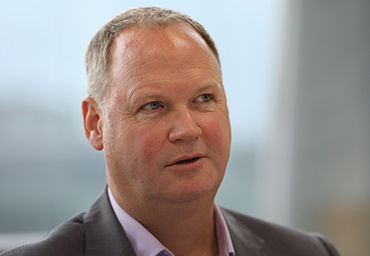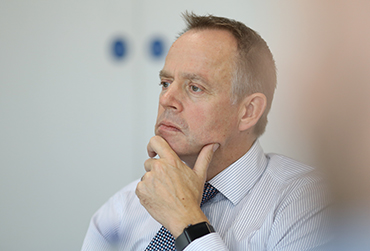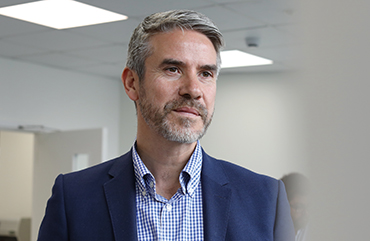
The topics under discussion ranged from consolidation in the sector, to the possible impact of Brexit, and a lot in between.
And while opinions varied on some topics, the key area that everyone agreed on was that while the market is changing, there are still plenty of opportunities.
The title of today’s discussion is pretty broad, so let’s start with an equally broad topic: what are the key challenges facing the industry?
Aron Priest To stay relevant. Things are moving so quickly. Talking to Nick about different people in our space, people that haven’t got factories or equipment, but operate in the e-commerce space and are growing at a fast pace. The challenges are very different for e-commerce and traditional printing. How do they diversify [traditional printers] and for e-commerce how do we stay relevant? It’s such a big topic.

James Duckenfield
You mentioned those disruptors in the e-commerce space, are there also disruptors in the commercial space, wide-format – is the model essentially changing?
Nick Green Well, you guys [James] have done a big job on 3D. When we talk about staying relevant, I get frustrated that we haven’t worked out how to actually remind people that there are lots of exciting things going on in our medium. We could talk about personalisation of clothing, 3D printing, online and how that’s growing. I was with someone the other day who’s launching a cool new start-up around health and juices, and he was telling me about this great new product that he had found online, where they take your company brochure or media pack and turn it into a newspaper. I still think that the amount of awareness of the great things going on in our space is super buried. So, when you ask about the challenges we all face, there’s some great value in what we’re all doing, some great hidden secrets, but they’re still hidden.
James Duckenfield I think the elephant in the room though, is that document volumes are dropping. And there’s massive capacity in the litho world. We hear too much bad news about what’s happening in print, rather than focusing on what’s happened that’s good in print. I think businesses are separating into what are either product businesses – that are very good at producing specific types of products and are very competitive [as a result] – or services businesses – which don’t focus on a product, but are a one-stop shop and command a higher premium because there’s less hassle for the customer. I don’t think you can be both, you can have different parts of your business that are one or the other. I think that if you want to grow a business that has a downward trend line, the only way to really do that is grow by acquisition. So, I think there will be a lot more consolidation in the traditional markets, but those that have specialised will do very well.
Robert Lockwood I think the challenges in the commercial print sector, where you have that falling demand, is the head in the sand, ostrich mentality that something will turn up. But the progressive companies ought to be talking about what can we do, how can we consolidate. But there has to be value in it, because when you look at the value of most printers there’s not a lot in there – so what are you buying? If a printer is struggling then you’re often better off sitting on your hands and waiting for them to fail, but that volume then quickly dissipates – just look at what happened to Anton.
 Nick Green
Nick Green
Charles Jarrold The overall picture is that the volume market is shrinking, and parts of the market are actually shrinking quite quickly. Costs are also going up – so inevitably margins are being squeezed and that’s a big challenge. So, what’s the answer to that? The answer is that you have to find a way to create more value, somehow, within your business model.
NG That’s the interesting point isn’t it. Obviously we have Canon here, but in the wider space, we’ve been looking at some recent capex decisions. What’s interesting is that you’ve still got manufacturers coming up with new [litho] presses, that aren’t less money, and the cost of paper is going up – so are the manufacturer’s even helping themselves let alone us?
CJ It’s a perfect analogy with the web offset market, where the presses got bigger and bigger and faster and faster. But the market [requirement] went in the opposite direction. Digital, I think is different, because the model and pricing is different, and there is the opportunity to provide more variety and probably reflect the direction of print.
Web offset is an interesting case study, but it’s a condensed market in the sense of the number of players…
CJ Well, it is now.
What I mean is, if the model was last man standing, it’s pretty much played out now.
CJ I never think last man standing is a strategy. Consolidation has been interesting, because it took a very long time to play out. But, to be fair, the consolidators have played a very smart game in buying unwanted assets in a market that has been shrinking and that’s generated value for them as businesses, where that ends up, I’m not sure.
Jason Hammond But aren’t we looking inward rather than outward. We should be saying to our clients: what are your pain points, let me solve them. It doesn’t have to be print, it doesn’t have to be digital, it doesn’t have to be technology. It can be service. That’s what we’ve all got to do, stop looking in and start looking out towards our clients.
CJ That’s the exciting direction.
JH It’s the only way we can go to keep hold of a diminishing market. And that’s a very different place to be, where you’re measured by your service levels rather than your output, by your ROI rather than the number of PrintWeek Awards...
Which are great, for the record.
JH [Laughs] Which are great.
NG But quite expensive. [Laughter].
 Jason Hammond
Jason Hammond
I think it gets us back to James’ polarising view, that you’re either a product- or service-based business. Looking around the table, wouldn’t you all consider yourselves service businesses?
Paul Manning Everyone talks about diversification, because we’re trying to protect our turnover, protect our margin. We’re trying to do more for the people that are spending less with us. So, our challenge is we want our businesses to deal with more people. Whether, you’re online or offline, I think I’m right in saying if you want to keep your turnover it’s likely it will be made up of more customers. Online [print businesses] have been great at that, because they picked up part of the market that we’re awful at. Our challenge as commercial printers is that we need to deal with more customers and they will want more from us [in lower volumes], so it’s not just diversification it’s that what one customer used to spend 10 years ago now takes five. But we still have to keep our costs down.
Which I gets back to Nick’s point of how do we make print more attractive, so that it’s easier to recruit talent, especially for those new roles?
CJ The challenge is that the perception [of print] is formed by what people see every day, and that’s newspapers and magazines. But that’s just a tiny part of the sector. So, people have a view of what print is, and actually it’s not, it’s a £13.8bn sector, newspaper and magazines are just 8% of that. Yes, they’ve had a hard time – meanwhile there’s all this growth going on elsewhere [in the sector]. We do a lot of apprenticeship training, and we helped with an event at Ravensbourne [University London] we had a print space with five member companies, what was interesting there was that we had all these kids turning up and they were just wowed. I was really concerned that we would be overwhelmed by the Googles and BBCs of this world, but it was the opposite – there was an immediate engagement. So, there’s definitely a perception gap there.
JD The culture of print businesses 20 years ago is very different from what it has to be now to attract new talent.
AP We’re about to build a cool area for [technical/developer] staff to work, we’re even thinking of installing bunkbeds for people to work from laptops, on flexi hours. Which is all pretty difficult for me to comprehend. [Laughter]. But it works and will help us attract the kind of people who will help take our industry, well our space, to the next level.
NG But there are lots of companies like that: you’ve got Moo, Moonpig, Solopress, Printed.com, Helloprint, you’ve got Touchnote doing cool things. And that’s only one part of it, around this table and beyond you have many successful, profitable businesses. It gets me back to the first point: that it still feels to me, as someone who has been in this industry for a long time, that either I don’t get it, or we’re always somehow trying to apologise for the sector. I went to a competitor’s event recently and they were saying that the average age in the business is 27, it feels like a tech start-up, no one is making an excuse for the industry they’re in, they love the industry and are proud of it.
And they’re then creating print advocates in that business, which then spread elsewhere…
NG But they’re also just running a good business. I think that’s the other point, not everyone is going to be transforming into some weird, sexy, dot-com, e-commerce thing, a lot of those businesses fail anyway. There’s the other side, like Paul said, sometimes doing more isn’t always the answer, if you’ve got good sales, making good money and are growing, it’s too easy to get distracted and say ‘I must be online, I must try these other things’, sometimes you just need to be focused and be good at what you’re doing. Having a good business, making money and growing at a sensible 5%-10% rate is no bad thing. It’s not always helpful to get distracted and try new things.
 Charles Jarrold
Charles Jarrold
JH The print industry is not terribly good at running businesses efficiently, managing costs and being flexible, historically. But I think we’re getting much, much better.
Touching on the point earlier about apologists: creating a sustainable business that offers security for staff is incredibly important isn’t it? And there’s no shame in making a profit.
PM Damn right. Going back to Nick though, some of the problems we’ve had where we’ve made just outright mistakes, has been when we’ve ignored what we’re good at and decided to try something completely new. I’m not saying don’t take risks, because sometimes they do work, but we’ve tried somethings that just ended up being a massive distraction. It’s sometimes not the ‘thing’ that you’re trying that is the mistake, it’s the distraction. I’m not saying that you shouldn’t diversify – we’ve done things that have worked really well – you just have to be bloody careful.
JH I think it’s good to have challenger ideas, but they have got to have their own leadership.
Stuart Rising Speaking as a supplier though, how do you think we can help with those challenger ideas – do you look to your suppliers for innovation, or does it come from your own observations?
AP Your own observations, but then it depends. If you have a corporate structure, you have to run the numbers, and then run them again, but when you’re not in a corporate role you can go on gut.
JH I don’t think anyone goes on their gut quite like the British do though [laughter]. I don’t think we should though...
AP I’ve done a lot on gut in the past [laughs].
RL We definitely only invest if we can almost guarantee ROI. If we’re moving into a new market, then I’m very cautious about that because I’ve inherited mistakes from the past, for example a Karat press, which was like the Betamax of digital. But the thing I find frustrating when talking about capex with manufacturers, is that they could be more helpful by adopting their modelling to the real world of a printer rather than some hypothetical model.
PM The scary thing I hear, and I hear it a lot, is when I’m talking to someone and ask them how it’s going and they reply, ‘not great, but we’re going to buy this new press and it’s going to save us this much time’. Sometimes those plans are good, but the idea that a new press is going to save you is the worst idea – especially if you’re already struggling to fill the capacity you have.
JD It’s like having another child to save a marriage. [Laughter].
CJ It’s just flawed business thinking really. Unless you have so much work you could bring in, and you’re working flat out and you’ve tackled your downtime and all the other issues around productivity.
 Robert Lockwood
Robert Lockwood
PM If you’re going from two presses to one, I get that, but if you’re swapping one for another because its ‘well fast’ well...
CJ Actually, I was talking to someone just yesterday, and it’s something we need to think about as a trade association, but one of the challenges is getting the users and buyers of print to understand what’s happened with the technology and what the capabilities are today. Because if they’re a buyer or marketer how are they going to understand what the possibilities are if we don’t go and talk to them as an industry.
JD [But] there are fewer professional print buyers out there, in my view.
All Definitely.
RL We come up against that all that time, sometimes the clients don’t understand the basics like there’s a lead time on paper. It’s an opportunity too though, the fact that the buyers on the ground are increasingly deskilled, which means we can fill a gap and become a trusted partner for them. If we can build a relationship with them. Because too often the least sexy role in our client’s marketing team is the print role, so people change so regularly.
But as you said isn’t that an opportunity to take on the lead supplier model?
RL It is.
JH But then you’re doing a lot of education and PR, and then you have to do it again and again...
JD That’s what I would like to see from the big manufacturers: them explaining to marketing departments the power of print, versus just digital.
CJ I agree with that, but I think it should be about the power of print when combined with digital. But getting back to the buyer point, there’s the expertise of buyers, that’s definitely an issue, but we also need to work with marketers to try and get out of them the value, the returns, the response rates to create case studies and share the value. Because what we have struggled to do is explain what is possible with print.
NG Personally, I think one of the biggest things over the next few years will be the use of things like APIs [application programming interfaces], we’re working with a company that has a goal of creating an environment where loads of people are creating print work and it’s being printed [across a network of printers] via APIs, using up capacity at a rate that people are happy to print at. It takes away the boundaries of printing...
CJ So, it’s a hub almost.
NG Certainly. There are big corporates that, although not based here in the UK, still do printing here and if you’ve got a commercial print business and you’re looking at ways to get capacity through your business that doesn’t just rely on sales people to generate the work, today you can create direct links with corporates that are changing the way they buy print.
CJ That’s essentially taking the model that has worked well in the consumer space, it’s saying let’s use online technology to make it much easier...
JH...and cheaper...
NG ...and you’re not employing sales people and the work is going straight through to your presses, it’s a print ready file and you don’t touch it.
JD But it’s a commoditised model rather than a services model.
 Paul Manning
Paul Manning
NG I agree with that, but I think when I look at our business then it’s a margin blend. I don’t mind having a business that has different gross margins in it, provided it allows us to grow and we can manage the costs properly. For example, there’s very little cost associated with the work we put through our partner network, it goes straight out to the partner and then straight out to the customer, so it’s not touching my factory, my despatch team or my customer services really. So, even though the gross margin is very different, the net margin isn’t.
Looking around the table, though, you have all diversified into new markets or applications – what is the key to that? How are you spotting those opportunities?
RL I can only talk for us, but it’s about talking to our clients and trying to understand where they want to be and how they’re spending money and then supporting them in that. And we’re trying to move our culture into much more of a ‘yes’ culture. It has to be the case of listening to the client when they say, ‘I’ve got this problem, how can you help me’. Diversification is being driven by clients.
NG There’s another way to think about it, it’s almost like the question is are we trying to save the industry? I’m not sure that’s right...
RL It isn’t right. We are a huge industry...
NG We are. And is it really any different from other industries, the auto industry is all consolidated, the airlines are consolidated every industry has, broadly speaking, consolidated over the years. Print is no different. Businesses that are badly run will go out of business, that’s the reality.
CJ And they should.
NG But the industry is absolutely fine. Yes, there’s an element of shrinking and product changing going on, but is that different from any industry? Look how the high street has changed, but good businesses are still doing well.
CJ The numbers in the sector broadly show that. It’s still a £13.8bn industry, it’s reduced over the past 10 years, but the rate of decline is pretty flat. As some sectors shrink others grow.
NG But it’s a shift in products.
AP And print is not dead. I read a survey from Norway recently and it said that 20% or 30% of people retain less information when they see it on a screen. They retain more information from print. People still love a printed product.
SR And we’re seeing that in the growth of printed books; that’s a big part of the business we’re involved in.
CJ The point isn’t whether a technology is or isn’t good. The point is that print gives you an engagement and does things because it’s a certain type of technology that delivers a message to you in a certain way as a human that online doesn’t. That’s why it remains relevant.
JH And that’s the same in retail, it’s got to be an experience and it’s got be an experience that you have chosen. If you look at Apple stores for instance, well this is a retailer that’s working and you go in and you get the experience you want. You get a dedicated person that helps, that upsells, that educates and you think that’s just fabulous. And that’s the way that we should approach print too.
RL We’re doing elements of that now. We employ people who are just there to advise clients on the retail customer experience, what are the trends, how can they make the experience more engrossing and then what they’re doing off the back is that is saying that we can help you with this, this and this. But it all starts with a customer journey and not talking about print. Print is secondary for us, it’s all about the service and filling in the gaps.
JH You have to do that. We have to measure the success, because in digital you can and we have to in print. So, you’ve got to have that shopper agency, you’ve got to understand the customer journey and you’ve got to be able to be able to say that piece of POS or DM worked and prove it.
PM And the perception of print is higher now than it ever has been. If our kids get a letter through the door, it’s the most exciting thing ever. Until they open it and it’s a bill. [Laughter]. But the perception of print among the young couldn’t be higher, because their world is all digital.
 Aron Priest
Aron Priest
How can the industry capitalise on that though?
PM I don’t think you need to capitalise, you just need to be there to get the work that suits you and make money out of it. As Nick said earlier; we just need to concentrate on the areas that we can do a good job in. Why is it not good enough to just say ‘we’re really good at that and we’re going to push that as much as is possible’? Yes, we’ve got other things we can do too, but you can become a bit bland if you try and do everything.
CJ You’ve got to be really good at what you do, but have one eye on where the world is going.
SR But I think you’re also right about getting mail through the post. A big proportion of the customers we deal with are transactional or direct mail and certainly the feedback we’re getting from the UK and Europe is that high-quality DM is getting much better returns than previously. Because we all know that when we get home and check our Gmail and we’ve got all of this spam that we just delete. Now you get two or three pieces of mail and you look at them. If it’s relevant.
CJ And if it is relevant it hangs around the house.
JD I even caught my wife picking up PrintWeek.
Really? Well I can’t blame her.
[Laughter].
In terms of investments though, whatever market you’re in, is it a case of invest in the latest technology or die?
JH Not blindly. There’s got to be a very good business case that offers a payback in the right amount of time. You’ve got to have the customer base and know that the workload will stay for the length of that investment. It’s a very difficult game to be in.
AP It’s about partnerships. You don’t have to keep on building more factories and filling them, the Europeans have shown us that partnerships really work.
And you see some companies that do that, they work with partners and grow that part of the business and when it gets to a certain point then they invest in it.
AP It’s a good way of testing the market or product too.
Do you think we’re open to those kinds of partnerships in the UK?
AP I think so; we’re getting there.
PM We can’t all keep building empires of kit in warehouses, we can’t keep buying equipment if the volumes are declining, we’ve got to network the printing because otherwise we’re all just buying the same kit to fight over the same work.
NG As a rule, the partners we work with they see us as just one income line. Yes, it’s probably at a lower margin than their own work, but it’s filling capacity and there’s money in it, and it goes straight through the business. It’s not a question of if the model works, it’s already here, and it’s going to grow in my opinion, but it’s not going to be for everybody.
PM I agree. We’ve done it and we still do it now and it’s great. The only problem is that MIS suppliers are not keeping up with it, your MIS will tell how much a job is on your press, but it can’t tell you ‘oh by the way’...
Are you getting back to what Nick was talking about earlier, APIs?
PM We deal with APIs all the time. It’s definitely the way, but some of the MIS suppliers are still struggling with APIs.
RL I think there is a fundamental thing, coming back to what you said Darryl, in that if we’re just talking about litho print it’s a very unforgiving market. The old model used to be that you could buy a press, which is an expensive piece of kit, run it for a large number of years and still be getting a return out of it. But that’s changing. And that’s where I’m finding a frustration with the manufacturers, because they’re still working on the old model. For us, we could be spending £4m on a new press, but is that going to be competitive in five years’ time? Technology is moving on. But you do have to keep investing, because there comes a point when you’re just not competitive – because if you’re running a 12-year-old press, there would be a point when it doesn’t make any sense. Makereadies would be terrible, repairs, breakdowns – it wouldn’t work, especially if you’re comparing with the latest generation of litho press. The thing I find odd is that if you go around printers in Europe, and perhaps I’ve only seen the really good printers, but most of their litho assets – digital is a different model – they never seem more than three years old – and I don’t understand how that works.
JD Because they sell their secondhand machines to the UK.
RL Well, there’s an element of that because that was why I was over there. [Laughter]. But I don’t understand how their funding model works and they can keep pumping that investment in.
NG That’s what I was saying at the very beginning: what are the manufacturers doing to also work with us. Because even in my world digital presses today can be north of half a million or a million, when your average order value is £70 then that doesn’t really add up. There are some new entrants, that are super good quality, but are 20% of the price of the [top end] machines.
CJ It’s a conundrum, because if you’re in the litho market the question isn’t ‘do I invest’ it’s ‘when do I invest’, because if you’re not investing then your decision is effectively to get out of the game. Because all that happens is your bills get bigger and bigger.
 Stuart Rising
Stuart Rising
What about automation? Paul mentioned staffing costs earlier – is automation another area that the manufacturers can help in?
AP They already are.
SR It’s certainly a conversation that we have a on a daily basis, around efficiencies and automation. Getting better utilisation of the people in the organisation. And a lot of the earlier conversation really resonated, having to come up with some incredibly creative financial models that are different from the norm. Over the past 12 to 18 months we’ve seen more and more of that, trying to work out what works for the customer and their balance sheet and then coming up with a model that works for us as well.
JH Going back to the staffing point: we need our staff to be multi-skilled. The rest of the world has moved on, but we’ve been a bit slow to do it. We’ve got production staff, account management staff, admin staff, technology staff... actually we need all of them to do all of those roles to be truly efficient.
PM I think a few years ago we thought, wrongly, that we would be able to automate everything eventually and how great that would be. Actually, where it’s worked out really well is where we have been able to automate the low-value, admin-heavy stuff – which frees us up to deal with the stuff that has got a higher value. But we couldn’t do that if we were also trying to book in 30 sets of business cards, it would be ridiculous. It’s great when it works, because there’s nothing better than seeing something hit the press and go out the door when no one has touched it. But, we don’t want to push anyone away, we still want a relationship with a customer, we don’t want to push them to the website if they want to carry on talking to ‘Harry’.
We spoke about consolidation earlier; do you think there is a lot more to come?
AP There’s definitely room for more.
RL In the B2B market I’ve always felt there should be more consolidation, but looking at what’s been happening, you don’t really see much consolidation, it’s more about business failure.
NG Also, consolidation is sometimes seen as negative word, but actually some people just want to sell their company.
JD I saw a stat recently, and I can’t remember the exact numbers, but it said that an astonishing percentage of business owners in our sector were approaching retirement age.
RL I saw that, it’s a huge percentage.
JD It was something along the lines of 80%. And if that’s true then there’s going to be a hell of a lot of consolidation in our sector.
JH And consolidation can work, we acquired a £25m-turnover business 18 months ago and it’s been a massive success, the location works, because it’s different and the kit works, because its different. It had a similar customer base, but again different.
CJ But there is a point of trying to facilitate business owners’ exit process so that they don’t run on and the assets get heavily depreciated and the clients start to disappear.
RL Well, there’s another point to that: where you have businesses going down that curve, and that’s the impact they have on pricing in the market. Because they’re pricing for a total different set of circumstances...
CJ Running for cash.
RL Yes. I did start a strategy six or seven years ago where we looked to acquire businesses, but I didn’t see a single business that by the time they were prepared to talk had a business worth selling, because they had got to the point where there was no value left. But if they had started the conversation a year before...
JD I think’s it’s advisors giving too high a value.
CJ I think that’s back to the asset price versus the cashflow price, it’s also about trying to create the luck for people to have the conversations at the right time.
I’m conscious of time, and we need to start wrapping up – so it looks like we’re not going to be able to talk about the final agenda point: Brexit.
JH But I would love to know if anyone does have an answer. [Laughter]. But what should we say to our customers when they ask, ‘what are you doing about Brexit?’
AP I get calls from my dad about Brexit, he wants to know what happens if he’s booked a flight for afterwards as he’s heard all flights will be grounded. I just tell him ‘dad, it will be fine’.
CJ Your advice to him is actually quite good for the sector. But you might want to have a look at your contracts, you might want to see what force majeure says, you might want to talk to a lawyer around that.
JD You think Brexit is force majeure?
CJ It depends, probably not.
NG I don’t know how many of our businesses are genuinely being affected, right now, by Brexit though?
JD It definitely is [having an effect]…
JH There is an uncertainty that is causing a lot of customers just to hold back.
RL We’re looking at it from the perspective in that that we need to create an agile business model with agile business thinking that can react quickly. Because looking around the table we don’t know what the answer is going to be, there might be an eleventh hour great Brexit deal...
PM ...or planes might fall out of the sky. [Laughter].
RL The truth is there is a wide spectrum of possible outcomes, we can’t model them all.
JD There will be a market adjustment, but life will go on.
NG Life will go on. So, we need to be aware of not being super negative. If something goes materially wrong with Brexit I’m sure we will be affected. But it’s balancing that worry with not every single printer in the UK is having a bad week because of Brexit.
JH And export could end up being a big opportunity.
RL And if Brexit does create an opportunity we all need to be able to grab it, whatever it is.
Which seems a good place to end.
Delegates
James Duckenfield chief executive Hobs Group
Nick Green founder Printed.com
Jason Hammond chief executive The Delta Group
Charles Jarrold chief executive BPIF
Robert Lockwood group chief executive Taylor Bloxham
Aron Priest managing director Solopress
Paul Manning managing director Rapidity
Stuart Rising head of Commercial Print Group Canon UK










